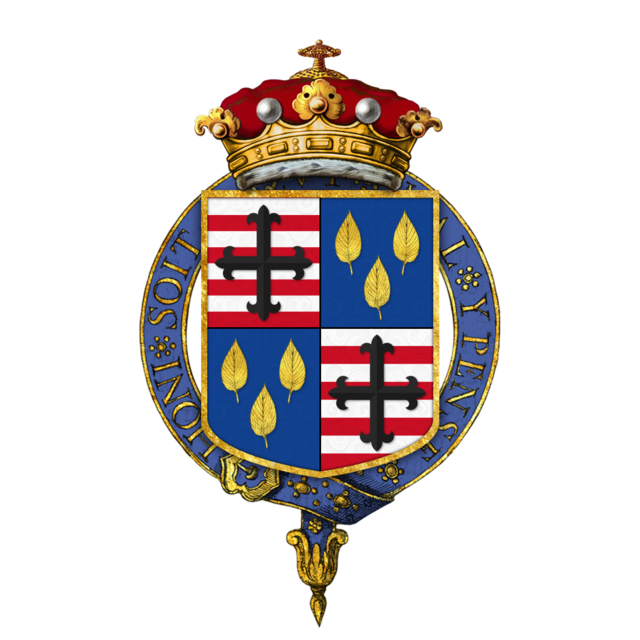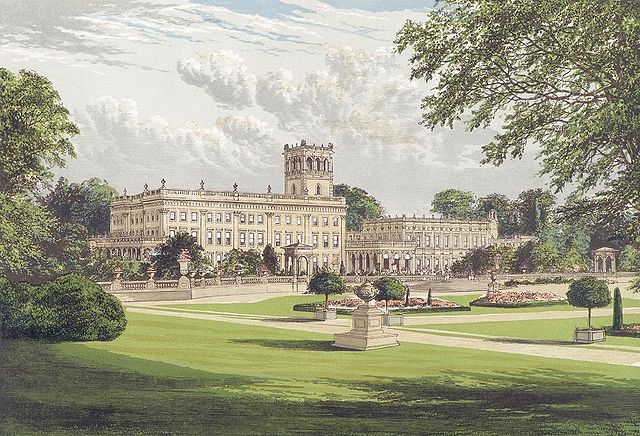British politician (1721–1803) From Wikipedia, the free encyclopedia
Granville Leveson-Gower, 1st Marquess of Stafford, KG PC (4 August 1721 – 26 October 1803), known as Viscount Trentham from 1746 to 1754 and as The Earl Gower from 1754 to 1786, was a British politician from the Leveson-Gower family. Sitting in the House of Lords, he spent a quarter of a century in the Cabinet.
The Marquess of Stafford | |
|---|---|
 Portrait by George Romney | |
| Lord Privy Seal | |
| In office 22 December 1755 – 30 June 1757 | |
| Monarch | George II |
| Prime Minister | Thomas Pelham-Holles, 1st Duke of Newcastle-upon-Tyne William Cavendish, 4th Duke of Devonshire |
| Preceded by | Charles Spencer, 3rd Duke of Marlborough |
| Succeeded by | Richard Grenville-Temple, 2nd Earl Temple |
| In office 27 November 1784 – 1794 | |
| Monarch | George III |
| Prime Minister | William Pitt the Younger |
| Preceded by | Charles Manners, 4th Duke of Rutland |
| Succeeded by | George Spencer, 2nd Earl Spencer |
| Lord President of the Council | |
| In office 22 December 1767 – 24 November 1779 | |
| Monarch | George III |
| Prime Minister | William Pitt, 1st Earl of Chatham Augustus FitzRoy, 3rd Duke of Grafton Frederick North, Lord North |
| Preceded by | Robert Henley, 1st Earl of Northington |
| Succeeded by | Henry Bathurst, 2nd Earl Bathurst |
| In office 19 December 1783 – 1 December 1784 | |
| Monarch | George III |
| Prime Minister | William Pitt the Younger |
| Preceded by | David Murray, 7th Viscount Stormont |
| Succeeded by | Charles Pratt, 1st Earl Camden |
| Personal details | |
| Born | 4 August 1721 |
| Died | 26 October 1803 (aged 82) Trentham Hall, Staffordshire |
| Nationality | British |
| Political party | Tory |
| Spouse(s) | (1) Elizabeth Fazakerley (d. 1745) (2) Lady Louisa Egerton (d. 1761) (3) Lady Susanna Stewart (d. 1805) |
| Children |
|
| Parent(s) | John Leveson-Gower, 1st Earl Gower Lady Evelyn Pierrepont |
| Alma mater | Christ Church, Oxford |

Stafford was a son of John Leveson-Gower, 1st Earl Gower (1694–1754) and his wife Lady Evelyn Pierrepont. His maternal grandparents were Evelyn Pierrepont, 1st Duke of Kingston-upon-Hull and his first wife Lady Mary Feilding. Mary was a daughter of William Feilding, 3rd Earl of Denbigh and his wife Mary King. His father was a prominent Tory politician who became the first major Tory to enter government since the succession of George I of Great Britain, joining the administration of John Carteret, 2nd Earl Granville in 1742. Gower was educated at Westminster School and Christ Church, Oxford.[1]

Stafford was elected to Parliament in 1744.
With the death of his elder brother in 1746, he became known by the courtesy title of Viscount Trentham until he succeeded his father as Earl Gower in 1754. He built the earlier Lilleshall Hall, converting a 17th-century house located in the village of Lilleshall into a country residence around the late 1750s.
Stafford was associated with the faction of John Russell, 4th Duke of Bedford, who was his brother-in-law, and as a member of that faction, called the "Bloomsbury Gang", was given many governmental positions. Following Bedford's death in 1771, Gower became leader of the group, and as Lord President of the Council in the administration of Frederick North, Lord North, he was a key supporter of a hard-line policy towards the American colonists. Between 1775 and 1778, Stafford proceeded to make substantial alterations to his home at Trentham Hall based on the designs by Henry Holland.
By 1779, Gower resigned from the cabinet being frustrated by what he saw as the North administration's inept handling of the American Revolutionary War. When North resigned in March 1782, Gower was approached to form a ministry, but he refused, and he refused subsequent overtures from both Lord Shelburne and the Fox-North coalition to enter the government. Instead, he became a key figure in bringing about the fall of the Fox-North coalition, and was rewarded with the position of Lord President once again in the new administration of William Pitt the Younger. Although he soon exchanged this office for that of Lord Privy Seal, and gradually began to withdraw from public affairs, he remained a cabinet minister until his retirement later in 1794. In 1786, he was created Marquess of Stafford as a reward for his services.[1] He was elected Fellow of the Society of Antiquaries (FSA) on 28 April 1784.
In 1799 he (or his immediate family benefit trust) was estimated the fifth-wealthiest small family unit in Britain, owning £2.1 million (equivalent to £260 million in 2023)), having assets in land, mining and arterial canal-toll rights having speculatively invested in the latter projects, much of which was in Staffordshire's Black Country.[2]
He died at Trentham Hall, Staffordshire, on 26 October 1803.[1] He was the last surviving member of the Bloomsbury Gang.[3]

Stafford married three times. On 23 December 1744, he married firstly Elizabeth Fazakerley, daughter of Nicholas Fazakerley, with a dowry of £16,000 (equivalent to £3,441,000 in 2023). She died on 19 May 1745 of smallpox, the day after giving birth to a son, John, who died shortly after birth.[4]
Stafford married secondly Lady Louisa Egerton, daughter of Scroop Egerton, 1st Duke of Bridgewater, in 1748. She died in 1761. They were parents to four children:

Stafford married thirdly Lady Susanna Stewart, daughter of Alexander Stewart, 6th Earl of Galloway, 23 May 1768. They were parents to four children:
When Lord Stafford died at the age of 82, he was succeeded in his titles by his eldest son Lord George, who was created Duke of Sutherland in 1833. The Marchioness of Stafford died in August 1805.[1]
Seamless Wikipedia browsing. On steroids.